|
|

|
Magnificent Creations
The Grumman Lunar Module and its Contractor Model
by Andrew Lagomarsino
The Apollo Lunar Module occupies a unique niche in history as mankind's first true spaceship. Created to fullfill man's dream of touching another world, it could never return home. Instead, it was destined to remain in the beautiful, yet airless and unforgiving heavens.
At the Grumman Aerospace Corporation in Bethpage, New York, engineers became visionaries, creating a creature like nothing ever seen. Ugly yet beautiful, functional, and incredibly engineered, the Lunar Module (LM) completed its mission beyond anyone's and everyone's wildest expectations. Until we return to the Moon or go elsewhere, the LM will stand alone having delivered men to another world.
Such is the mantle history has reserved for Grumman's Lunar Module. As Neil Armstrong is surely aware, history holds a special place for "the first".
Unfortunately, relatively little Lunar Module paraphernalia remains as a testimonial to this lofty position, in either the public or private domain. It's said that President Richard Nixon ordered a fully functional LM buried in a Long Island landfill, along with the blueprints, production records, engineering documents, and manuals - all from Grumman.
The Contractor's Model
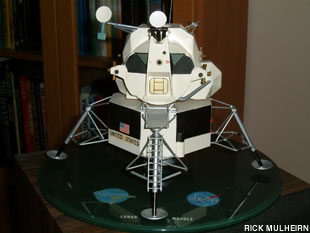
Beyond what resides in museums, one of the best ways to get an appreciation for this spacecraft is owning a LM contractor's model. Viewed by many today to be the most striking of all the Mercury, Gemini and Apollo era models, these replicas were given to dignitaries, subcontractors, astronauts and flight directors, among others. The model was often included in Apollo astronauts' official portraits.
Models also graced the desks of Grumman staff; at one time they were offered for $29.95 in the employee shops. Today, ten or twenty times that price might be a bargain basement starting point for a wreck of a model that can often sell at auction for thousands of dollars; in one case, almost $40,000.
The Lunar Module contractor models progressed through several distinct phases of construction. While there were many variations during the course of each build, the most easily recognized is the change to the appearance of the model's round base following the Apollo 11 landing.
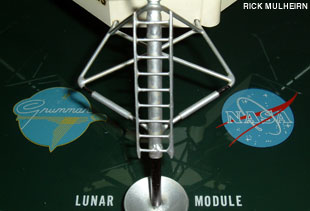
Models made prior to the first lunar landing have a NASA logo and Grumman logo; those made after (for the most part) include Neil's first step words, along with the NASA emblem and a smaller Grumman logo.
To an experienced eye, other variations to the model can now serve to identify its age and probable maker. One can often approximate a build date depending on the type of clearcoat used, metal, finish, etc. Identifying a vintage can be helpful in assessing a model and perhaps advising the next course of action to its owner. For example, clear- coats used on later builds tended to yellow more rapidly, and thus they must be protected from light exposure to a greater degree.
Records are not clear on how many companies produced the Grumman LM model.
Topping is well documented as having produced the earliest version; Precise is known to have made the last. If a third, unknown company bridged these two, they are unknown.
The number of models originally produced is an area of much conjecture,
as supporting documents are seemingly absent. The uppermost guess among
LM enthusiasts has been 40,000, though it was likely less.
The Model as a Collectible
Pristine examples of the LM model are virtually never seen today. Even with examples changing hands for thousands of dollars, the original beauty of the model has frequently faded.
A common flaw which greatly impacts the desirability, collectability, and value of a model is "yellowing", or the fading of the original milk white color to cream and finally to yellow, as these models can age with just modest exposure to sunlight.
Additionally there is a somewhat predicatable heirarchy of missing parts; these would include Reaction Control System (RCS) thrusters, rendevous radar and/or S-band antennae dishes, ladders, porches, lander legs and VHF antennae. It is fortunate that the base and the model's body was of simple and robust construction, or far fewer examples might exist today.
Another factor worthy of consideration is build quality. These LMs were handmade, and sometimes it becomes apparent that either the model maker was experiencing an off day, the process was rushed, or the parts were poorly formed. Generally, the early models built by Topping exhibit the highest build quality. This is not by any means however, a hard and fast rule.
It's suspected that when the estates of Grumman, NASA and other Apollo program personnel are exhausted, there will be few LM models to be found that are not already in the hands of museums and collectors. This could have a large impact on the pricing and availability of models at some point in the near future.
Even today, with models still entering the market, finding a pristine example is highly unlikely. That is not to say that collectors should give up all hope. Locating a model which appears to be near-perfect when viewed from 12 inches away is entirely possible in today's market. These are the models that make fine display pieces; they grace many of the top line, private collections around the world.
Repair & Restoration of OY-1
The following, by way of an example, describes the repair and restoration of a mid-level Grumman LM model.
This private restoration in many ways incorporates the limitations, budgetary concerns and other factors that restoration experts, collections managers, and museums deal with on a regular basis. These would include non-monetary factors, such as a love for, and respect of the artifacts, and an appreciation for what they represent.
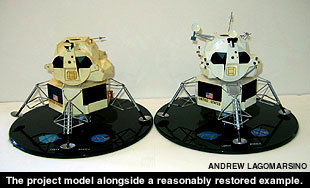
The budget was simply not available to turn OY-1 (Old Yeller One) into a museum masterpiece, but this specific model did have its merits. It was of decent build quality, a nice early variation, and it had what might be the most desirable of the pre-Armstrong quote bases, almost black in color. That said, this model did exhibit some physical damage, it was missing many pieces, and had a horrific case of yellowing.
While the restoration likely added monetary value only commensurate with the costs involved, OY-1's owner presented something far more important than a "price is no concern" desire for a museum trophy. This model had been a prized possession of his father, a Grumman employee who in the 1960's helped build the actual lunar landers for Grumman. Without such individuals, there would have been no "first step". The owner wished this family heirloom restored, in large measure, to show pride for what his father helped create.
The model had been treated like many of its day: proudly displayed in the home, but also used as a play toy for the children. It was certainly not something they gave thought to to protect for its appearance in the future. Given this history, one would correctly conclude that the model was in need of help to return it to its former glory.
Angle of Attack
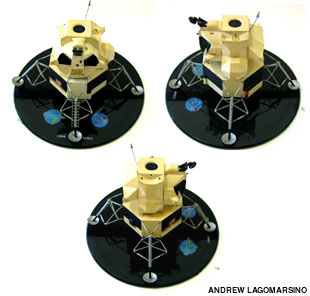
On intitial viewing, one was easily taken aback by the difficulties of restoring such a badly damaged example. OY-1 was missing an S-band antenna and it's bracket, part of one leg, the porch, all the RCS thrusters, the VHF antenna's coils, and was yellowed very badly. The owner had played with it as a child, unfortunately having some less than successful landings along the way. It then sat, untouched, but exposed to sunlight and other damaging elements for about 25 years.
While this project was not approached from a "value added" perspective, this was nonetheless a factor in planning the restoration. As this model would always have replicated parts, one goal was to not overextend the project monetarily beyond what could be justified on a cost/benefit ratio.
A plan was developed to incorporate available resources (as well as whatever could be justified) with the overriding focus and goal to achieve a final model that could be proudly displayed by the owner's family. Although the plan was partially abandoned in the midst of the project, it was a helpful as a starting point. The plan was modified as opportunities became available. As a result of these mid-course corrections, the project was more satisfying to the owner.
Changing Colors

Initially, the plan had been to leave the color of the LM as it was. However, once repairs were underway, the owner chose to allow an untested, possibly destructive method to be attempted to remove the yellowing. As this process nearly dissolved OY-1, and in an effort to avoid any other casualities, details of the procedure have been purposely withheld.
An ancillary goal was to preserve to the extent possible anything original on the model. This included the decals, which showed their age, but were otherwise intact.
Stripping each of the two stages involved about 12 to 15 hours of work. They were finished with 600 grit sandpaper and a high quality clearcoat.
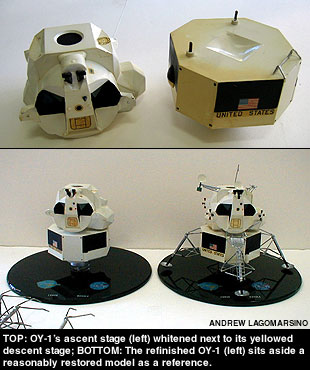
Metal Restoration
The next step was to restore the LM model's metal parts. The majority of contractor models were assembled using painted/plated semi-gloss metal, though there have been examples where at least some of the metal was chromed.
OY-1 had all semi gloss (read: no gloss, rusty) metal parts, making it easier to achieve a unified appearance between the old, repaired, and replicated parts.
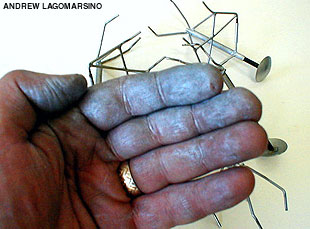
A proprietary compound that is part solvent, part pigment and part polish works well to faithfully replicate a finish that is a dead-ringer for the original finish on metal parts in pristine condition. This compound, when rubbed into the metal (using fingers and a lot of pressure) is authentic in appearance and very durable. A simple paint respray does not yield satisfactory results.
Ascent Stage
Following the restoration of the metal, it was necessary to obtain or replicate numerous parts for the ascent stage. A decision was made to keep the original rendezvous radar dish, which had broken and was missing a half; at least the dish was still there. The S-band antenna (the first part that is consistently lost on most models), it's bracket, the VHF antennae, and the RCS thrusters however, had to be replaced with replicas.
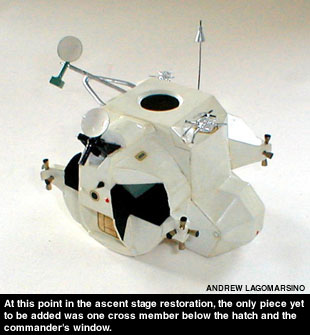
As built by Topping and Precise, S-band antennae came in two factory finishes: one almost turquoise blue and a rarer greenish blue variant. For OY-1, the choice of color was the lesser encountered.
Using parts from other models as a pattern, new thrusters and antennae were created. The previously mentioned compound was used to finish the S-band antenna's new metal support bracket and VHF antennae, along with the whip antenna, which was original.
Descent Stage
Having already repaired the partially missing lander leg along with the other metal pieces, the final hurdle was a replacement for the missing porch.
Time considerations (this project had already accounted for 60-plus hours) meant that there was not to be enough available to craft a fully satisfactory porch replica, though from an arm's length it's hard to tell that it is not original.
At this point in the project, the owner's goal of a display ready example had been achieved. Perhaps a future trip to the workshop will provide OY-1 with a proper porch.
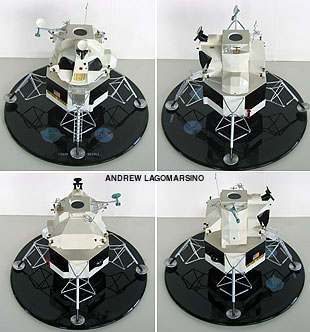
Frequently Asked Questions to the Author
Can I purchase or order from you the metal refinishing compound?
No, I will not sell any of the metal refinishing compound. It simply won't travel, and the finished look of the metal is very dependent on proper application.
Can you refinish the metal parts of my model for me?
Yes, I will refinish all the metal uniformly. The metal may be detached from the model and shipped to avoid it being necessary to send the whole model.
Are replacement parts available?
Yes, but they do not come cheap. A replicated S-band or rendevous radar dish is a hand-carved item and the price (without profit) for one painted and ready for installation is slightly over $100.00.
Do you need my model to make parts or can I send you photographs?
I cannot replicate individual parts based solely on scans of your model. If you need parts, the entire model must be shipped to me so that I can view its condition, to best duplicate an appropriate look.
Can you provide detailed instructions so that I can restore my own model myself?
I do not have the time or inclination at present to provide detailed, individual instruction.
Can you appraise my Grumman LM model?
I am not certified in any way, so I really can't appraise or state values for insurance purposes.
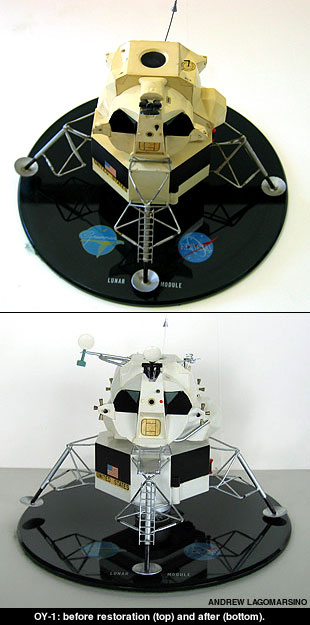
|

© 2022 collectSPACE.com All rights reserved.
Questions? E-mail contact@collectspace.com
|
|

|
Andrew Lagomarsino is a retired professional musician who lives in the wine country of Northern California. His collection of lunar module memorabilia includes original handwritten manual drafts and original LM artwork from Grumman, a set of sub system blueprints for Armstrong & Aldrin's LM 5, and an LM Familiarization Manual which bears the name "Anders", and which General Bill Anders of Apollo 8 recently indicated was very likely his personal copy when with NASA.
Author's Acknowledgements
Thank you to those space memorabilia collectors who have sought
restoration work, or who have included my occassional project model as a
part of a collection. It is an honor to have my handiwork represented in
some of the finest private collections of space memorabilia in the world.
Thanks too to Rick Mulheirn, owner of my very first LM model, for giving her a
loving home, giving her new decals, and for bringing Joe, OY-1's owner
and I together. And to Larry, who's hand facilitated so much.
To Donnis, Russel, and Jim, who got the ball rolling, and who in early
conversations helped me to embrace the singularly historic nature of the
Grumman LM.
Of course thanks to Joe for trusting me with OY-1, and for sharing his
friendship and family's legacy heirloom with me. There could be no
higher honor.
Above all, thanks to all the Grumman guys and
gals I have come in contact with over the years who have been so
wonderful to share their stories. May your legacy live forever.
|

|










